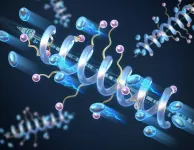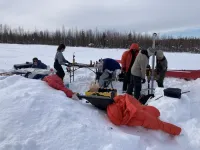(Press-News.org) NEW YORK, NY (Aug. 8, 2024) -- Since the genetic code was first deciphered in the 1960s, our genes seemed like an open book. By reading and decoding our chromosomes as linear strings of letters, like sentences in a novel, we can identify the genes in our genome and learn why changes in a gene’s code affect health.
This linear rule of life was thought to govern all forms of life—from humans down to bacteria.
But a new study by Columbia researchers shows that bacteria break that rule and can create free-floating and ephemeral genes, raising the possibility that similar genes exist outside of our own genome.
“What this discovery upends is the notion that the chromosome has the complete set of instructions that cells use to produce proteins,” says Samuel Sternberg, associate professor of biochemistry & molecular biology at the Vagelos College of Physicians and Surgeons, who led the research with Stephen Tang, an MD/PhD student at the medical school.
“We now know that, at least in bacteria, there can be other instructions not preserved in the genome that are nonetheless essential for cell survival.”
“Astonishing” and “alien biology”
The scientific reaction had already made news a few months ago when the paper first appeared as a preprint. In a Nature News article, scientists called the discovery “alien biology,” “astonishing,” and “shocking.”
“It repeatedly left us in disbelief,” Tang says, “and we went from doubt to amazement as the mechanism gradually came into view.”
Bacteria and their viruses have been locked in battle for eons, as viruses try to inject their DNA into the bacterial genome and bacteria devise cunning methods (e.g. CRISPR) to defend themselves. Many bacterial defense mechanisms remain unexplored but could lead to new genome editing tools.
The bacterial defense system Sternberg and Tang picked to explore is an odd one: The system involves a piece of RNA with unknown function and a reverse transcriptase, an enzyme that synthesizes DNA from an RNA template. The most common defense systems in bacteria cut or degrade incoming viral DNA, “so we were puzzled by the idea of defending the genome by DNA synthesis,” Tang says.
Free-floating genes
To learn how the odd defense works, Tang first created a new technique to identify the DNA produced by the reverse transcriptase. The DNA he found was long but repetitive, containing multiple copies of a short sequence within the defense system’s RNA molecule.
He then realized that this portion of the RNA molecule folds into a loop, and the reverse transcriptase travels numerous times around the loop to create the repetitive DNA. “It’s like you were intending to photocopy a book, but the copier just started churning out the same page over and over again,” Sternberg says.
The researchers originally thought something might be wrong with their experiments, or that the enzyme was making a mistake and the DNA it created was meaningless.
“This is when Stephen did some ingenious digging and found that the DNA molecule is a fully functioning, free-floating, transient gene,” Sternberg says.
The protein coded by this gene, the researchers found, is a critical part of the bacteria’s antiviral defense system. Viral infection triggers production of the protein (dubbed Neo by the researchers), which prevents the virus from replicating and infecting neighboring cells.
Extrachromosomal genes in humans?
If similar genes are found freely floating around in cells of higher organisms, “that would really be a game-changing discovery,” Sternberg says. “There might be genes, or DNA sequences, that don't reside in any of the 23 human chromosomes. Maybe they're only made in certain environments, in certain developmental or genetic contexts, and yet provide critical coding information that we rely on for our normal physiology.”
The lab is now using Tang’s methods to look for human extrachromosomal genes produced by reverse transcriptases.
Thousands of reverse transcriptase genes exist in the human genome and many have still undiscovered functions. “There is a significant gap to be filled that might reveal some more interesting biology,” Sternberg says.
Gene-editing wellspring
Though gene therapies that take advantage of CRISPR editing are in clinical trials (and one was approved last year for sickle cell), CRISPR is not the perfect technology.
New techniques that combine CRISPR with a reverse transcriptase are giving genome engineers more power. “The reverse transcriptase gives you the ability to write in new information at sites that CRISPR cuts, which CRISPR alone cannot do,” Tang says, “but everyone uses the same reverse transcriptase that was discovered decades ago.”
The reverse transcriptase that creates Neo has certain properties that may make it a better option for genome editing in the lab and for creating new gene therapies. And more mysterious reverse transcriptases exist in bacteria that are waiting to be explored.
“We think bacteria may have a treasure trove of reverse transcriptases that could be opportune starting points for new technologies once we understand how they work,” Sternberg says.
More information
All authors: Stephen Tang, Valentin Conte, Dennis J. Zhang, Rimantė Žedaveinytė, George D. Lampe, Tanner Wiegand, Lauren C. Tang, Megan Wang, Matt W.G. Walker, Jerrin Thomas George, Luke E. Berchowitz, Marko Jovanovic, and Samuel H. Sternberg.
The research was supported by the NIH (Medical Scientist Training Program grant T32GM145440, Ruth L. Kirchstein Individual Predoctoral Fellowship F30AI183830, R35GM124633, R01AG071869, and R01HG012216); the National Science Foundation (Graduate Research Fellowship and Award 2224211); a Human Frontier Science Program postdoctoral fellowship (LT001117/2021-C); the Schaefer Research Scholars Program; the Hirschl Family Trust, a Pew Biomedical Scholarship, an Irma T. Hirschl Career Scientist Award, start-up packages from Columbia University and the Columbia University Vagelos College of Physicians and Surgeons’ dean’s office; and the Vagelos Precision Medicine Fund.
Samuel Sternberg is also an investigator in the Howard Hughes Medical Institute.
###
Columbia University Irving Medical Center (CUIMC) is a clinical, research, and educational campus located in New York City. Founded in 1928, CUIMC was one of the first academic medical centers established in the United States of America. CUIMC is home to four professional colleges and schools that provide global leadership in scientific research, health and medical education, and patient care including the Vagelos College of Physicians and Surgeons, the Mailman School of Public Health, the College of Dental Medicine, the School of Nursing. For more information, please visit cuimc.columbia.edu.
END
Bacteria encode hidden genes outside their genome—do we?
2024-08-08
ELSE PRESS RELEASES FROM THIS DATE:
Assistant professor's $1.1M NASA grant to develop computational tool aiding hypersonic vehicle design
2024-08-08
STARKVILLE, Miss.—NASA is awarding a Mississippi State University assistant professor a $1.13 million grant to develop a new simulation tool to aid the design of hypersonic vehicles used in space exploration.
Vilas Shinde of MSU’s Department of Aerospace Engineering won the grant to develop a new flow stability and transition analysis tool, which will aid researchers and aircraft designers in understanding and predicting changes associated with the boundary layer—air flow in the vicinity of an aircraft’s ...
Houston Methodist study shows new, more precise way to deliver medicine to the brain
2024-08-08
Houston Methodist researchers have discovered a more accurate and timely way to deliver life-saving drug therapies to the brain, laying the groundwork for more effective treatment of brain tumors and other neurological diseases.
In a study published this month in Communications Biology, an open access journal from Nature Portfolio, investigators used an electric field to infuse medicine from a reservoir outside the brain to specific targets inside the brain. This adds a new dimension to the 30-year-old process of injecting therapeutics into the brain through ...
A ‘thank you’ goes a long way in family relationships
2024-08-08
URBANA, Ill. – You’ve probably heard that cultivating gratitude can boost your happiness. But in marriage and families, it’s not just about being more grateful for your loved ones — it’s also important to feel appreciated by them. Researchers at the University of Illinois Urbana-Champaign have previously explored the positive impact of perceived gratitude from romantic partners for couples’ relationship quality. In a new study, they show the benefits of perceived gratitude ...
How a legal loophole allows unsafe ingredients in US foods
2024-08-08
The Food and Drug Administration (FDA) is tasked with overseeing the safety of the U.S. food supply, setting requirements for nutrition labeling, working with companies on food recalls, and responding to outbreaks of foodborne illness. But when it comes to additives already in our food and the safety of certain ingredients, FDA has taken a hand-off approach, according to a new article in the American Journal of Public Health.
The current FDA process allows the food industry to regulate itself when it comes to thousands of added ...
USC researchers develop AI model that predicts the accuracy of protein–DNA binding
2024-08-08
A new artificial intelligence model developed by USC researchers and published in Nature Methods can predict how different proteins may bind to DNA with accuracy across different types of protein, a technological advance that promises to reduce the time required to develop new drugs and other medical treatments.
The tool, called Deep Predictor of Binding Specificity (DeepPBS), is a geometric deep learning model designed to predict protein–DNA binding specificity from protein–DNA complex structures. DeepPBS ...
Increasing solid-state electrolyte conductivity and stability using helical structure
2024-08-08
Solid-state electrolytes have been explored for decades for use in energy storage systems and in the pursuit of solid-state batteries. These materials are safer alternatives to the traditional liquid electrolyte—a solution that allows ions to move within the cell—used in batteries today. However, new concepts are needed to push the performance of current solid polymer electrolytes to be viable for next generation materials.
Materials science and engineering researchers at the University of Illinois Urbana-Champaign have explored the role of helical secondary structure on the conductivity of solid-state peptide polymer ...
The threat of mpox has returned, but public knowledge about it has declined
2024-08-08
PHILADELPHIA – It has been two years since the World Health Organization declared a global health emergency over an outbreak of mpox, a disease endemic to Africa that had spread to scores of countries. Now, in the summer of 2024, a deadlier version of the infectious disease has spread from the Democratic Republic of Congo to other African nations, the strain that originally hit the United States has shown signs of a resurgence, and this week the Centers for Disease Control and Prevention (CDC) issued a new alert on mpox to health care providers.
But while the American public quickly learned about the disease during the summer of 2022, as ...
How does traumatic brain injury progress to Alzheimer’s disease?
2024-08-08
RIVERSIDE, Calif. -- A traumatic brain injury, or TBI, is caused by a contusion to the head that may result in injury to the brain. This type of injury combined with the inherited genetic risk factors can result in the accelerated development of Alzheimer’s disease and related dementia, or ADRD. TBIs range from mild to severe, with the majority being mild. They are especially common in adolescents engaging in contact sports and in the elderly who tend to fall with greater frequency as they age. Regardless of the source, TBI and how it progresses to ADRD is an understudied area of research.
A $3.5 million grant to the University of California, ...
Researchers find unexpectedly large methane source in overlooked landscape
2024-08-08
When Katey Walter Anthony heard rumors of methane, a potent greenhouse gas, ballooning under the lawns of fellow Fairbanks residents, she nearly didn’t believe it.
“I ignored it for years because I thought ‘I am a limnologist, methane is in lakes,’” she said.
But when a local reporter contacted Walter Anthony, who is a research professor at the Institute of Northern Engineering at University of Alaska Fairbanks, to inspect the waterbed-like ground at a nearby golf course, she started to pay attention. Like others in Fairbanks, they lit “turf bubbles” on fire and confirmed the presence of methane ...
Royal Commission for AlUla collaborates with SETI Institute to support development of Alula Manara Observatory
2024-08-08
Royal Commission for AlUla Collaborates with SETI Institute to Support Development of AlUla Manara Observatory
Experts from SETI Institute will support the advancement of telescope technology and data analysis at AlUla Manara Observatory.
The collaboration will enhance the future observatory's capabilities as it welcomes global scientists, researchers, and tourists interested in astronomy and space science.
Ambitions to foster curiosity, knowledge sharing, and upskilling local capabilities in astronomical and space sciences field
Mountain View, CA , 8 August 2024 -- The Royal Commission for AlUla (RCU) and SETI Institute ...




